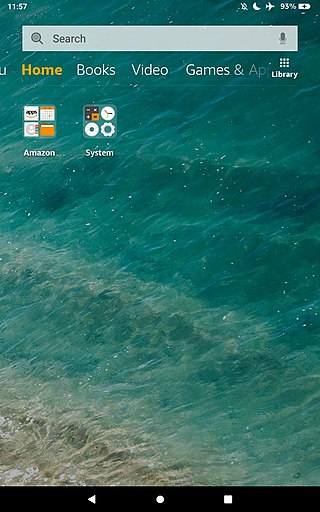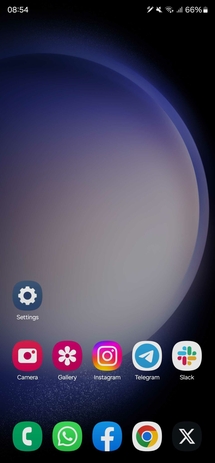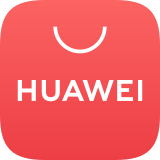The Android Package with the file extension apk is the file format used by the Android operating system, and a number of other Android-based operating systems for distribution and installation of mobile apps, mobile games and middleware. A file using this format can be built from source code written in either Java or Kotlin.

Fire OS is a mobile operating system based on the Android Open Source Project (AOSP). It is developed by Amazon for their devices. Fire OS includes proprietary software, a customized user interface primarily centered on content consumption, and heavy ties to content available from Amazon's storefronts and services.

The Huawei Watch and Huawei Watch 4 are HarmonyOS-based smartwatches developed by Huawei. The Huawei Watch, the first smartwatch produced by the company, was announced at the 2015 Mobile World Congress and released at IFA Berlin on September 2. The Huawei Watch 3 was introduced in June 2021 after the United States Department of Commerce added Huawei to its Entity List in May 2019.

The Huawei Mate series, formally the Huawei Ascend Mate series, is a line of high-end HarmonyOS-powered phablet smartphones produced by Huawei, and is one of their flagship products along with the Pura series.

EMUI (formerly known as Emotion UI, and also known as MagicOS is a HarmonyOS/Android mobile operating system developed by Chinese technology company Huawei. It is used on the company's smartphones and tablet computers.

One UI is a user interface (UI) developed by Samsung Electronics for its Android devices running Android 9 "Pie" and later. Succeeding Samsung Experience and TouchWiz, it is designed to make using larger smartphones easier and be more visually appealing. To provide more clarity, some elements of the UI are tweaked to match colors that are based on the color of the user's phone. It was announced at Samsung Developer Conference in 2018, and was unveiled in Galaxy Unpacked in February 2019 alongside the Galaxy S10 series, Galaxy Buds and the Galaxy Fold.

Android 10 is the tenth major release and the 17th version of the Android mobile operating system. It was first released as a developer preview on March 13, 2019, and was released publicly on September 3, 2019.

HarmonyOS (HMOS) is a distributed operating system developed by Huawei for smartphones, tablets, smart TVs, smart watches, personal computers and other smart devices. It has a multikernel design with dual frameworks: the operating system selects suitable kernels from the abstraction layer in the case of devices that use diverse resources. The operating system was officially launched by Huawei in August 2019.

Huawei Mobile Services (HMS) is a collection of proprietary services and high level application programming interfaces (APIs) developed by Huawei Technologies Co., Ltd. Its hub known as HMS Core serves as a toolkit for app development on Huawei devices. HMS is typically installed on Huawei devices on top of running dual-framework HarmonyOS operating system, and on its earlier devices running the Android operating system with EMUI including devices already distributed with Google Mobile Services. Alongside, HMS Core Wear Engine for Android phones with lightweight based LiteOS wearable middleware app framework integration connectivity like notifications, status etc.

Celia is an artificially intelligent virtual assistant developed by Huawei for their latest HarmonyOS and Android-based EMUI smartphones that lack Google Services and a Google Assistant. The assistant can perform day-to-day tasks, which include making a phone call, setting a reminder and checking the weather. It was unveiled on 7 April 2020 and got publicly released on 27 April 2020 via an OTA update solely to selected devices that can update their software to EMUI 10.1.

The Huawei P50 and P50 Pro are HarmonyOS-based high-end smartphones manufactured by Huawei. Unveiled on 21 July 2021, they succeed the Huawei P40 in the P series. In March 2023 Huawei released their successor Huawei P60 Series phones in China, and in May 2023 it released the Huawei P60 Pro in Europe.
Petal Maps is a map service based on TomTom provided by Huawei to devices with the operating system HarmonyOS, Android and iOS. It offers satellite imagery, aerial photography, 3D view surroundings, turn-by-turn navigation, head-up display and route planning for traveling by foot, car, bike, and public transportation.

DevEco Studio is the official integrated development environment (IDE) for Huawei's HarmonyOS operating system, built on JetBrains' IntelliJ IDEA software and Huawei's SmartAssist designed specifically for HarmonyOS development. It is available for download on Microsoft Windows and macOS based operating systems.
The version history of the HarmonyOS distributed operating system began with the public release of the HarmonyOS 1.0 for Honor Vision smart TVs on August 9, 2019. The first expanded commercial version of the Embedded, IoT AI, Edge computing based operating system, HarmonyOS 2.0, was released on June 2, 2021 for phones, tablets, smartwatches, smart speakers, routers, and internet of things. Beforehand, DevEco Studio, the HarmonyOS app development IDE, was released in September 2020 together with the HarmonyOS 2.0 Beta. HarmonyOS is developed by Huawei. New major releases are announced at the Huawei Developers Conference (HDC) in the fourth quarter of each year together with the first public beta version of the operating system's next major version. The next major stable version is then released in the third to fourth quarter of the following year.

OpenAtom OpenHarmony, or abbreviated as OpenHarmony (OHOS), is a family of open-source operating systems based on HarmonyOS derived from LiteOS, donated the L0-L2 branch source code by Huawei to the OpenAtom Foundation. Similar to HarmonyOS, the open-source distributed operating system is designed with a layered architecture, which consists of four layers from the bottom to the top, i.e., the kernel layer, system service layer, framework layer, and application layer.
HarmonyOS NEXT is a proprietary distributed operating system and an iteration of HarmonyOS, developed by Huawei to support only HarmonyOS native apps. The operating system is primarily aimed at software and hardware developers that deal directly with Huawei. It does not include Android's AOSP core and is incompatible with Android applications.
Ark Compiler, also known as ArkCompiler, is a unified compilation and runtime platform that supports joint compilation and running across programming languages and chip platforms, also operating systems of open-source OpenHarmony, Oniro OS, alongside proprietary HarmonyOS with single core system HarmonyOS NEXT included on native APP in Event-driven programming in a unified development environment and formerly built for Android-based EMUI for Huawei smartphones and tablets with HMS-enabled apk apps on AppGallery that improves app performance. It supports a variety of dynamic and static programming languages such as JS, TS, and ArkTS. It is the compilation and runtime base that enables OpenHarmony, Oniro OS alongside HarmonyOS NEXT to run on multiple device forms such as smart devices, mobile phones, PCs, tablets, TVs, automobiles, and wearables. ArkCompiler consists of two parts, compiler toolchain and runtime.
Huawei HiCar is a mobile app developed by Huawei to mirror features of an Android EMUI and HarmonyOS device, such as a smartphone, on a car's dashboard information and entertainment head unit.











